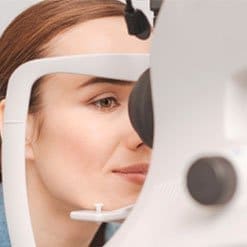Vision defects
GET TO KNOW THE FOUR COMMON VISION DEFECTS
Most people at some point in their life will experience at least one of four common vision defects .Each of them can be easily detected and corrected during routine eye examinations with an ophthalmologist. Even if you do not see anything disturbing and you feel that your vision is correct, regular consultations are essential. Only in this way, can you detect serious problems and eye diseases.
We recommend visiting an ophthalmologist at least once a year.
Check your sight now.
Have your Amsler test carried out
- Astigmatism
It causes distorted or blurred vision and usually occurs together with hyperopia or myopia.
In case of astigmatism the front part of eye (cornea) is more oval (like an “egg”) rather than round (like a “ball”) shape. Because the surface of the eye has such an irregular shape, the rays falling on the back part of eye cannot be properly focused , which causes distorted or blurred vision. Even the smallest astigmatism can cause headache and fatigue. It can be corrected by both glasses and contact lenses. Years ago, due to the unique structure and shape of the eye, contact lenses could not meet the requirements need for astigmatism correction. Today, thanks to fascinating development in technology , soft contact lenses are a great alternative for anyone with astigmatism.
- Myopia
Problems with vision at a distance.
The defect usually appears before the age of 20, at school age. In this defect, the eyeball is too long or the cornea too curved. Light entering the eye is not focused properly, which causes that a person with myopia cannot see objects that are far away. Squinting while watching TV or having trouble reading road signs or text on school boards are the most common symptoms of myopia.
- Hyperopia
Trouble with seeing objects from near.
This defect is difficult to detect during school examinations. In this defect, the eyeball is too short or the cornea is too little curved. People with this defect most often see perfectly objects at a distance, but have difficulty seeing objects that are close. In more than half of those people, correction of vision is necessary due to hyperopia.
- Presbyopia
Presbyopia (presbyopia) manifests itself with difficulties seeing objects in close proximity.
The defect occurs gradually around the age of 40. With age, the lens of the eye loses its elasticity, which leads to bigger and bigger problems with sharpening the image seen from near. Reading fine print with effort or difficulties in performing activities requiring close-up viewing are often one of the first symptoms.
Until recently, the best form of correction of presbyopia were only glasses. Now, the latest technology enabled the correction of this defect by means of bifocal soft contact lenses. These lenses provide correct vision both from near and afar. But the real breakthrough was the introduction of the lens. MultiLive with additional alternating effect of distance vision and near vision. This lens provides a maximum of good vision without undue lowering the sense of contrast – the decisive factor for comfortable vision . Regular sight examinations will help you to detect the beginnings of this defect and apply appropriate methods of correction.






